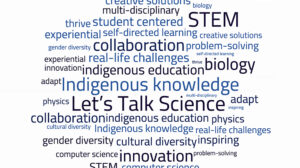Empowering School Leaders: Identifying the Support Teachers Require to Cultivate GenAI in Education
Over two decades ago, Prensky (2001) highlighted a profound shift in society, marked by the emergence and widespread adoption of digital technology – a significant change that irrevocably altered the landscape. This observation remains as pertinent today as it was then, particularly in light of the emergence of Generative Artificial Intelligence (GenAI) in educational contexts. Neglecting GenAI in today’s educational sphere is akin to disregarding the ubiquity of cell phones; even if educators do not witness its direct use, students are undoubtedly leveraging its capabilities. Rather than debating whether AI will influence education, the pertinent question now is: “What support do teachers require from school administrators to effectively integrate GenAI into the contemporary classroom?”
What is GenAI?
Generative Artificial Intelligence (GenAI) refers to a variety of programs that can create everything from images, music and artwork to spoken and written text. “Generative AI is used as an umbrella term to describe machine learning solutions trained on massive amounts of data in order to produce output based on user prompts” (Sætra, 2023, p. 1). It is able to generate this content based on patterns learned from existing data. As users of GenAI provide it with data, the output it provides gets better, faster and more personalized (Tetu, 2023).
What does the research have to say about GenAI?
There is a growing body of literature and recommendations for reform in the post-secondary education sector (ie: Eaton, 2023; Heaven, 2023; Volante et al., 2023) yet, the impact of GenAI in secondary education has not been sufficiently explored. The gap in the research is most noticeable in the context of the perspectives of teachers, who are at the forefront of navigating and mediating students’ use of GenAI.
The importance of the teacher’s role increases in a technological classroom (Ozgur, 2020). Choosing to ignore the technology that students have access to is equivalent to neglecting reality. Teachers of twenty-first-century learners “need to be willing to take risks alongside their students recognizing that their students may have more expertise with technology than they do” (Sharma & Parr, 2018). In fact, a teacher’s expertise in educational technology plays a tremendous role in the quality of the technology integration to support learning and instruction (Backfisch, et al., 2020).
A Turnitin (2023) study found that nearly half of post-secondary students say they are regular users of GenAI while only approximately 29% of faculty are regular users.There is a clear divide in skills between students and educators. While these statistics are drawn from the postsecondary level, the evident gap in GenAI utilization between students and educators likely extends to secondary schools, reflecting a border trend in technological proficiency in younger generations compared to their educators. This divide underscores the pressing need for understanding what secondary educators need in order to understand GenAI and to integrate GenAI tools into secondary school curricula and their teaching practices. Thus, it should be used as another technological learning tool alongside the calculator, spelling and grammar checking software and collaboration tools like Google Workspace.
GenAI can offer personalized learning for students. It can take the form of adaptive learning systems, intelligent tutoring systems, and other systems that improve the quality of assessment and evaluation processes, instructions, and learning (Sharma et al., 2019). GenAI provides students with improved learning experiences because of its ability to customize and personalize learning materials to the needs and capabilities of students (Chen et al., 2020).
It can also generate subject material. Chassignol et al. (2018) note that GenAI can develop content, suggest teaching methods, assess student work and communicate between teachers and students. ChatGPT can generate interactive educational materials such as quizzes (Dijkstra et al., 2022) and flashcards (Singh et al., 2022). It can also promote children’s curiosity and lead them to ask deeper questions (Abdelghani et al., 2022).
GenAI is powerful and has the potential to permeate and heavily change different sectors of society, with the education sector being one that is likely to be transformed by it (Timms, 2016). It is within this context that it is important to understand how to manage the impact by offering the words of our research participants, secondary teachers, to add voice to the suggestions our research points to.
What do the teachers in this inquiry have to say about GenAI and the support they need?
Research points to the importance of teachers’ agentive role when using GenAI. To effectively integrate GenAI into education, teachers’ AI-specific technological and pedagogical knowledge is vital (Celik, 2023). Scholars have found that human-AI collaboration leads to more effective learning than humans or AI working alone (e.g. Holstein et al., 2020; Kim et al., 2022; Xu & Ouyang, 2022). It is within this context that we undertook qualitative research to understand teachers’ perspectives on the proliferation of GenAI. By employing semi-structured interviews with secondary teachers, we were able to create a snapshot of what school administrators can do to support teachers. Supporting teachers is essential not only for their morale but as Klem and Connell (2004) show, supporting teachers improves student engagement and achievement.
Acknowledge Teachers’ Concerns
“The [school] board is not currently discussing it. It is not included in our policy and there has been at least in what I’ve seen limited open discussion about it. Even a limited willingness to discuss it…I kind of feel hopeless. At times, I feel overwhelmed. Are we all feeling that overwhelmed?” (Rebecca, secondary teacher for 6 years).
Teachers cite a lack of direction and coherent policy. Due to the absence of clear guidance on GenAI, discussions surrounding it are fragmented into isolated pockets. Principals and teachers exercise discretion in dealing with GenAI use, resulting in inconsistency or approaches that do not effectively foster learning. Many perceive the topic as sensitive, leading to secretive conversations, as teachers are uncertain of what their school administrators’ reactions might be. Many teachers express concerns or anxieties about AI technologies impacting their student learning but are unable to share those fears and tribulations with their school administrators or even amongst their peers.
Perception is reality, so the findings of this research underscore the importance for school administrators to acknowledge teachers’ concerns, whether positive or negative, about GenAI. Principals and school boards should acknowledge these concerns and create an open dialogue where teachers feel comfortable expressing their feelings and openly learning about the technologies.
Provide Transparent Communication
“[We shouldn’t be using GenAI] until we know more about it and have some direction. I need to learn more about it at this point. I feel quite ignorant with generative AI technology…I think in the future I’m definitely going to have to look into trying to figure out how to check reports/assignments for AI enhancement. I know there are tools out there where you can check if it is you know the work is generated by AI, but I do not know how to do that. I think it’ll be left up to the teachers to figure out how to do that…but I need direction” (Sarah, secondary teacher for 24 years).
Transparency is essential in addressing teachers’ apprehensions about GenAI. School administrators should keep teachers informed about changes in the school’s technology landscape, including whether or not GenAI can be integrated into the curriculum or classroom environment and how to respond to instances when a student has used GenAI when it was not part of the original task.
Teachers recognize that formulating a policy at this early stage might pose challenges, but a desire exists for consistent guidelines across schools and districts. Additionally, they advocate for the initiation of dialogues, noting that discussions surrounding the topic of GenAI have thus far been limited to whispered conversations within teacher workspaces. Teachers would like to engage in conversations with school leaders so that, together, they can construct guidelines that respect professionalism, learning and academic integrity.
Provide Support
“I’m hopeful and not, at the moment…I’m hopeful that we’ll get time in the right PD, but I’m discouraged. I don’t know how fast it’s going to come, because that’s not the focus right now in our board…it’s going to be a process to get there. But we just need the support. We need the higher ups and we need, like for everything else, we need the right PD. We need professional people coming in and teaching us how to use the AI so that we’re not always left to our own devices. We don’t have the time for that. If you’re a computer guy or a math guy, you might figure it out really fast. But other people, as they’re slow to learn things, will not get there. And then you have students who, like everything else, have teachers that are young or have teachers that are interested in it and going really fast. And then other teachers are nowhere near there. Right? I just think that there’s an equity issue there” (Dawn, secondary teacher for 16 years).
Teachers want support in the tools for capacity building. They want to know how to redesign their evaluations so that students do not just have GenAI complete the task. They want to know how to design assignments so that students use GenAI – learn that skill – and then demonstrate student learning. However, this is not a trivial task and would require professional development, guidance, time, and a firm commitment. Additionally, teachers seek to understand how GenAI can be integrated into the learning process, empowering students to utilize it as an effective learning tool. Teachers express a need for the freedom to engage in open discussions about GenAI, as they perceive it as a restricted topic of conversation. Merely ignoring or suppressing the topic will not resolve the ills GenAI can bring but exacerbate them.
In addition, in most cases, teachers are aware of when students utilize external aids and when a student submits work that does not align with their known skill level. This self-reliance is not well-founded, though, when it comes to GenAI, as shown by Kumar and Mindzak (2024). Nevertheless, teachers desire the ability to intervene and engage the students in dialogue. However, they feel uncertain whether they will have administrative support in such situations. Teachers perceive their responsibility as ensuring students acquire knowledge and exhibit skills, and if AI is involved in this process, they seek further information but harbor concerns that administrators may view their approach as unjust. They want school districts to decide on a consistent way to detect cases of unwarranted use of GenAI and a consistent way to respond to unwarranted use.
Many teachers feel unprepared or uncertain about integrating AI technologies into their teaching practices. They want school principals to provide ongoing professional development opportunities focused on AI literacy and practical strategies for incorporating AI tools effectively into the classroom, aiming to enhance capacity building in this area.
Promote Collaboration and Peer Learning
“The board could hire people [for] who this is their field of expertise. So, they could teach people. First of all, how it works. The pros and cons. And specifically teach us as teachers…how do we use it to benefit our teaching practices? Because. I think that right away the connotation is AI equals cheating and not thinking. And I think people just have a reaction, like I have at times…but, we need PD surrounding how we navigate this. And, what are some positives that we could take from this, and what are some things that we need to be cautious and aware of” (Caroline, secondary teacher for 18 years).
Encourage teachers to collaborate and share experiences with integrating AI technologies. This can be done through peer mentoring programs, professional learning communities (PLCs), or workshops where teachers can learn from each other’s successes and challenges. Teachers want to learn more about AI but are unsure if they will be supported in their inquiry.
Teachers cite a desire to learn how to harness GenAI but feel like they do not have the time. In this sense, teachers want to learn from technology leaders who can research different GenAI tools and explore how they can be used as part of the learning process. Then, these technology leaders can teach the classroom teachers but also co-teach in the classroom because their background knowledge about GenAI will allow them to pivot in response to student’s actions and needs.
Concluding Remarks
At present, fear pervades, prompting teachers to fall back on traditional, pen-and-paper activities in the classroom, effectively resorting to evaluation methods outdated by over a decade. As Dawson (2023) has said, education must “prepare students for their future, not our past.” In this sense, it is important that school administrators lean in to listen to what teachers are saying. GenAI is not a fad that will disappear; it is here to stay. The direction for action is clear: a united effort involving teachers and administrators to reshape the educational landscape. This includes not only aiding teachers with their professional hurdles but also reconsidering how we educate our youth to equip them for a future vastly different from our history.
ABOUT THE AUTHORS:
Dr. Sunaina Sharma is an Ontario with over twenty years’ experience where she serves as both an in-school program leader and teacher. She prioritizes learners’ needs in her program planning, classroom instruction, and professional development initiatives. Her scholarly pursuits focus on exploring effective integration of digital technology in educational settings to enhance student engagement. She also contributes her experience as an instructor and practicum advisor in the Department of Educational Studies at Brock University, in Ontario. In this capacity, she draws upon her extensive classroom background to prepare future educators for their roles.
Dr. Rahul Kumar, is Assistant Professor in the Department of Educational Studies at Brock University, St. Catharines, ON, Canada. He is at the forefront of integrating artificial intelligence (AI) into education practices while preserving academic integrity. His recent research delves into the ethical implications and transformative potential of AI in maintaining and enhancing the integrity of academic pursuits.
REFERENCES:
Abdelghani, R., Wang, Y.-H., Yuan, X., Wang, T., Lucas, P., Sauzéon, H., & Oudeyer, P.-Y. (2022). GPT-3-driven pedagogical agents for training children’s curious question-asking skills. https://doi.org/10.48550/arxiv.2211.14228
Backfisch, I., Lachner, A., Hische, C., Loose, F., & Scheiter, K. (2020). Professional knowledge or motivation? Investigating the role of teachers’ expertise on the quality of technology-enhanced lesson plans. Learning and Instruction, 66, 1-13. https://doi.org/10.1016/j.learninstruc.2019.101300
Celik, I. (2023). Towards Intelligent-TPACK: An empirical study on teachers’ professional knowledge to ethically integrate artificial intelligence (AI)-based tools into education. Computers in Human Behavior, 138, 107468. https://doi.org/10.1016/j.chb.2022.107468
Chassignol, M., Khoroshavin, A., Klimova, A., & Bilyatdinova, A. (2018). Artificial intelligence trends in education: A narrative overview. Procedia Computer Science, 136, 16-24. https://doi.org/10.1016/j.procs.2018.08.233
Dawson, P. (2023). Don’t fear the robot: Future-authentic assessment and generative artificial intelligence. Werklund School of Education. University of Calgary. https://werklund.ucalgary.ca/dont-fear-robot
Dijkstra, R., Genç, Z., Kayal, S., Kamps, J., Sosnovsky, S., Brusilovsky, P., & Lan, A. (2022). Reading comprehension quiz generation using generative pre-trained transformers. CEUR Workshop Proceedings, 4-17.
Eaton, S.E. (2023). Postplagiarism: Transdisciplinary ethics and integrity in the age of artificial intelligence and neurotechnology. International Journal of Educational Integrity, 19(1), 1-10. https://doi.org/10.1007/s40979-023-00144-1
Heaven, W. D. (2023, April 6). ChatGPT is going to change education, not destroy it. MIT Technology Review. https://www.technologyreview.com/2023/04/06/1071059/chatgpt-change-not-destroy-education-openai/
Holstein, K., & Aleven, V. (2022). Designing for human–AI complementarity in K-12 education. AI Magazine, 43(2), 239-248. https://doi-org.proxy.library.brocku.ca/10.1002/aaai.12058
Kim, J., Lee, H., & Cho, Y. H. (2022). Learning design to support student-AI collaboration: Perspectives of leading teachers for AI in education. Education and Information Technologies, 27, 6069-6104. https://doi-org.proxy.library.brocku.ca/10.1007/s10639-021-10831-6
Klem, A. M., & Connell, J. P. (2004). Relationships matter: Linking teacher support to student engagement and achievement. Journal of School Health, 74(7) 262-273. https://doi.org/10.1111/j.1746-1561.2004.tb08283.x
Kumar, R., & Mindzak, M. (2024). Who wrote this? Detecting artificial intelligence-generated text from human-written text. Canadian Perspectives on Academic Integrity, 7(1), 1-9. https://doi.org/10.55016/ojs/cpai.v7i1.77675.
Ozgur, H. (2020). Relationships between teachers’ technostress, technological pedagogical content knowledge (TPACK), school support and demographic variables: A structural equation modeling. Computers in Human Behavior, 112, 106468. https://doi.org/10.1016/j.chb.2020.106468
Prensky, M. (2001). Digital natives, digital immigrants. On the Horizon, 9(5), 1-6.
Sætra, H. S. (2023). Generative AI: Here to stay, but for good? Technology in Society, 75, 102372. https://doi.org/10.1016/j.techsoc.2023.102372
Sharma, S., & Parr, M. (2018). Technology and student engagement: What educational leaders and teachers need to know. CAP Journal: Technology Leader or Leading Technology, Fall, 17-20. https://mzpinc.ca/ebooks/CAP/PDFs/CAP-T0318.pdf
Sharma, R. C., Kawachi, P., & Bozkurt, A. (2019). The landscape of artificial intelligence in open, online and distance education: Promises and concerns. Asian Journal of Distance Education, 14(2), 1-2. Retrieved from https://www.asianjde.com/ojs/index.php/AsianJDE/article/view/432
Singh, P. K., Wierzchoń, S. T., Chhabra, J. K., & Tanwar, S. (2022). Futuristic trends in networks and computing technologies select proceedings of fourth International Conference on FTNCT 2021. https://doi.org/10.1007/978-981-19-5037-7
Tetu, L. (2023, December 20). Better, faster, more personalized: How GenAI has us hooked on remarkable experiences. Fast Company. https://www.fastcompany.com/91001314/better-faster-more-personalized-how-generative-ai-has-us-hooked-on-remarkable-experiences
Timms, M. J. (2016). Letting artificial intelligence in education out of the box : Educational cobots and smart classrooms. International Journal of Artificial Intelligence in Education, 26(2), 701-712. https://doi.org/10.1007/s40593-016-0095-y
Turnitin. (2023). GenAI in higher education: Fall 2023 update of time for class study. https://tytonpartners.com/app/uploads/2023/10/GenAI-IN-HIGHER-EDUCATION-FALL-2023-UPDATE-TIME-FOR-CLASS-STUDY.pdf
Volante, L., DeLuca, C., & Klinger, D. A. (2023, February 27). ChatGPT and cheating: 5 ways to change how students are graded. Queen’s University. https:/ educ.queensu.ca/news/chatgpt-and-cheating-5-ways-change-how-students-are-graded
Xu, W., & Ouyang, F. A. (2022). A systematic review of AI role in the educational system based on a proposed conceptual framework. Education and Information Technologies, 27, 4195-4223. https://doi-org.proxy.library.brocku.ca/10.1007/s10639-021-10774-y










